An Efficient IAKF Approach for Indoor Positioning Drift Correction
Abstract
:1. Introduction
2. System Architecture
3. Improvement in Algorithm of Positioning Point Shift and Simulation Results
3.1. The Moving Average Method
3.2. The Least Square Method
3.3. Kalman Filter Algorithm
3.4. Improved Adaptive Kalman Filter Algorithm
3.5. Simulation Results
4. Experiment Results
4.1. Improvement Result of Static Positioning Point Shifting
4.2. Result of Improved Surrounding Crowd’s Influence
4.3. Improvement Result of Dynamic Positioning Point Shifting
5. Conclusions
Author Contributions
Funding
Institutional Review Board Statement
Informed Consent Statement
Data Availability Statement
Conflicts of Interest
References
- Lin, K.H.; Ye, D.G. Sensing Error Compensation Algorithm for Ultra-Wideband Following Systems. In Proceedings of the IEEE International Conference on Consumer Electronics-Taiwan (ICCE-TW), Penghu, Taiwan, 15–17 September 2021. [Google Scholar]
- Mainetti, L.; Patrono, L.; Sergi, I. A Survey on Indoor Positioning Systems. In Proceedings of the International Conference on Software, Telecommunications and Computer Networks (SoftCOM), Split, Croatia, 17–19 September 2014. [Google Scholar]
- Hameed, A.; Ahmed, H.A. Survey on Indoor Positioning Applications Based on Different Technologies. In Proceedings of the International Conference on Mathematics, Actuarial Science, Computer Science and Statistics (MACS), Karachi, Pakistan, 24–25 November 2018. [Google Scholar]
- Sadowski, S.; Spachos, P. RSSI-based indoor localization with the internet of things. IEEE Access 2018, 6, 30149–30161. [Google Scholar] [CrossRef]
- Wu, K.; Xiao, J.; Yi, Y.; Chen, D.; Luo, X.; Ni, L.M. CSI-based indoor localization. IEEE Trans. Parallel Distrib. Syst. 2013, 24, 1300–1309. [Google Scholar] [CrossRef] [Green Version]
- Lashkari, A.H.; Parhizkar, B.; Ngan, M.N.A. WIFI-Based Indoor Positioning System. In Proceedings of the Second International Conference on Computer and Network Technology, Bangkok, Thailand, 23–25 April 2010. [Google Scholar]
- Yassin, A.; Nasser, Y.; Awad, M.; Al-Dubai, A.; Liu, R.; Yuen, C.; Raulefs, R.; Aboutanios, E. Recent advances in indoor localization: A survey on theoretical approaches and applications. IEEE Commun. Surv. Tutor. 2017, 19, 1327–1346. [Google Scholar] [CrossRef] [Green Version]
- Cheng, Y.; Zhou, T. UWB Indoor Positioning Algorithm Based on TDOA Technology. In Proceedings of the International Conference on Information Technology in Medicine and Education (ITME), Qingdao, China, 23–25 August 2019. [Google Scholar]
- Yan, B.; Xiaochun, L. Research on UWB Indoor Positioning Based on TDOA Technique. In Proceedings of the International Conference on Electronic Measurement & Instruments, Beijing, China, 16–19 August 2009. [Google Scholar]
- Sang, C.L.; Adams, M.; Hörmann, T.; Hesse, M.; Porrmann, M.; Rückert, U. An Analytical Study of Time of Flight Error Estimation in Two-Way Ranging Methods. In Proceedings of the International Conference on Indoor Positioning and Indoor Navigation (IPIN), Nantes, France, 24–27 September 2018. [Google Scholar]
- Sophiya, S.S.; Gupta, K.A.; Yellampalli, S.S. Analysis of a Transmitter System for IEEE 802.15.4a UWB Standard. In Proceedings of the International Conference on Innovative Mechanisms for Industry Applications (ICIMIA), Bangalore, India, 5–7 March 2020. [Google Scholar]
- Niemelä, V.; Haapola, J.; Hämäläinen, M.; Iinatti, J. An ultra wideband survey: Global regulations and impulse radio research based on standards. IEEE Commun. Surv. Tutor. 2017, 19, 874–890. [Google Scholar] [CrossRef] [Green Version]
- Martynenko, D.; Fischer, G.; Klymenko, O.; Kreiser, D.; Olonbayar, S. High-Band Ultra-Wideband Transmitter for IEEE 802.15.4a Standard. In Proceedings of the IEEE International Conference on Ultra-Wideband (ICUWB), Sydney, NSW, Australia, 15–18 September 2013. [Google Scholar]
- Kim, H.J.; Xie, Y.; Yang, H.; Lee, C.; Song, T.L. An efficient indoor target tracking algorithm using TDoA measurements with applications to ultra-wideband systems. IEEE Access 2019, 7, 91435–91445. [Google Scholar] [CrossRef]
- Wang, T.Q.; Sekercioglu, Y.A.; Neild, A.; Armstrong, J. Position accuracy of time-of-arrival based ranging using visible light with application in indoor localization systems. J. Lightwave Technol. 2013, 31, 3302–3308. [Google Scholar] [CrossRef]
- Yang, B.; Li, J.; Shao, Z.; Zhang, H. Robust UWB indoor localization for NLOS scenes via learning spatial-temporal features. IEEE Sens. J. 2022, 22, 7990–8000. [Google Scholar] [CrossRef]
- Hajiakhondi-Meybodi, Z.; Mohammadi, A.; Hou, M.; Plataniotis, K.N. DQLEL: Deep Q-learning for energy-optimized LoS/NLoS UWB node selection. IEEE Trans. Signal Process. 2022, 70, 2532–2547. [Google Scholar] [CrossRef]
- Alarifi, A.; Al-Salman, A.; Alsaleh, M.; Alnafessah, A.; Al-Hadhrami, S.; Al-Ammar, M.A.; Al-Khalifa, H.S. Ultra wideband indoor positioning technologies: Analysis and recent advances. Sensors 2016, 16, 707. [Google Scholar] [CrossRef] [PubMed]
- Poulose, A.; Han, D.S. UWB indoor localization using deep learning LSTM networks. Appl. Sci. 2020, 10, 6290. [Google Scholar] [CrossRef]
- Taok, A.; Kandil, N.; Affes, S. Neural networks for fingerprinting-based indoor localization using ultra-wideband. J. Commun. 2009, 4, 267–275. [Google Scholar] [CrossRef]
- Elsanhoury, M.; Mäkelä, P.; Koljonen, J.; Välisuo, P.; Shamsuzzoha, A.; Mantere, T.; Elmusrati, M.; Kuusniemi, H. Precision positioning for smart logistics using ultra-wideband technology-based indoor navigation: A review. IEEE Access 2022, 10, 44413–44445. [Google Scholar] [CrossRef]
- Schwarzbach, P.; Weber, R.; Michler, O. Statistical evaluation and synthetic generation of ultra-wideband distance measurements for indoor positioning systems. IEEE Sens. J. 2022, 22, 4836–4843. [Google Scholar] [CrossRef]
- Teoman, E.; Ovatman, T. Trilateration in Indoor Positioning with an Uncertain Reference Point. In Proceedings of the IEEE 16th International Conference on Networking, Sensing and Control (ICNSC), Banff, AB, Canada, 9–11 May 2019. [Google Scholar]
- Shi, D.; Mi, H.; Collins, E.G.; Wu, J. An indoor low-cost and high-accuracy localization approach for AGVs. IEEE Access 2020, 8, 50085–50090. [Google Scholar] [CrossRef]
- Cao, Y.; Li, M.; Švogor, I.; Wei, S.; Beltrame, G. Dynamic range-only localization for multi-robot systems. IEEE Access 2018, 6, 46527–46537. [Google Scholar] [CrossRef]
- Zhang, Z.; Jiang, Z.; Meng, X.; Cheng, S.; Sun, W. Research on Prediction Method of API Based on the Enhanced Moving Average Method. In Proceedings of the International Conference on Systems and Informatics (ICSAI2012), Yantai, China, 19–20 May 2012. [Google Scholar]
- Lin, K.; Lu, C.; Chen, H.; Li, H.; Chuang, C. A Modified Least Squares Iteration for Indoor Positioning System. In Proceedings of the IEEE International Conference on Consumer Electronics—Taiwan (ICCE-TW), Taipei, China, 12–14 June 2017. [Google Scholar]
- Kalman, R. A New Approach to Linear Filtering and Prediction Problems. J. Basic Eng. 1960, 82, 35–45. [Google Scholar] [CrossRef] [Green Version]
- Zhang, G.; Bao, K.; Jiang, T.; Lu, W. Indoor Localization Algorithm Based on Combination of Kalman Filter and Clustering. In Proceedings of the International Wireless Communications & Mobile Computing Conference (IWCMC), Tangier, Morocco, 24–28 June 2019. [Google Scholar]
- Shi, Z.; He, Q.; Liu, Y. Accelerating parallel jacobi method for matrix eigenvalue computation in DOA estimation algorithm. IEEE Trans. Veh. Technol. 2020, 69, 6275–6285. [Google Scholar] [CrossRef]
- Zhang, C.; Kuhn, M.J.; Merkl, B.C.; Fathy, A.E.; Mahfouz, M.R. Real-time noncoherent UWB positioning radar with millimeter range accuracy: Theory and experiment. IEEE Trans. Microw. Theory Tech. 2010, 58, 9–20. [Google Scholar] [CrossRef]
- Liu, K.; Li, Z. Adaptive Kalman Filtering for UWB Positioning in Following Luggage. In Proceedings of the Youth Academic Annual Conference of Chinese Association of Automation (YAC), Jinzhou, China, 6–8 June 2019. [Google Scholar]
- Xu, Y.; Shmaliy, Y.S.; Li, Y.; Chen, X. UWB-based indoor human localization with time-delayed data using EFIR filtering. IEEE Access 2017, 5, 16676–16683. [Google Scholar] [CrossRef]
- Feng, D.; Wang, C.; He, C.; Zhuang, Y.; Xia, X. Kalman-filter-based integration of IMU and UWB for high-accuracy indoor positioning and navigation. IEEE Internet Things J. 2020, 7, 3133–3146. [Google Scholar] [CrossRef]



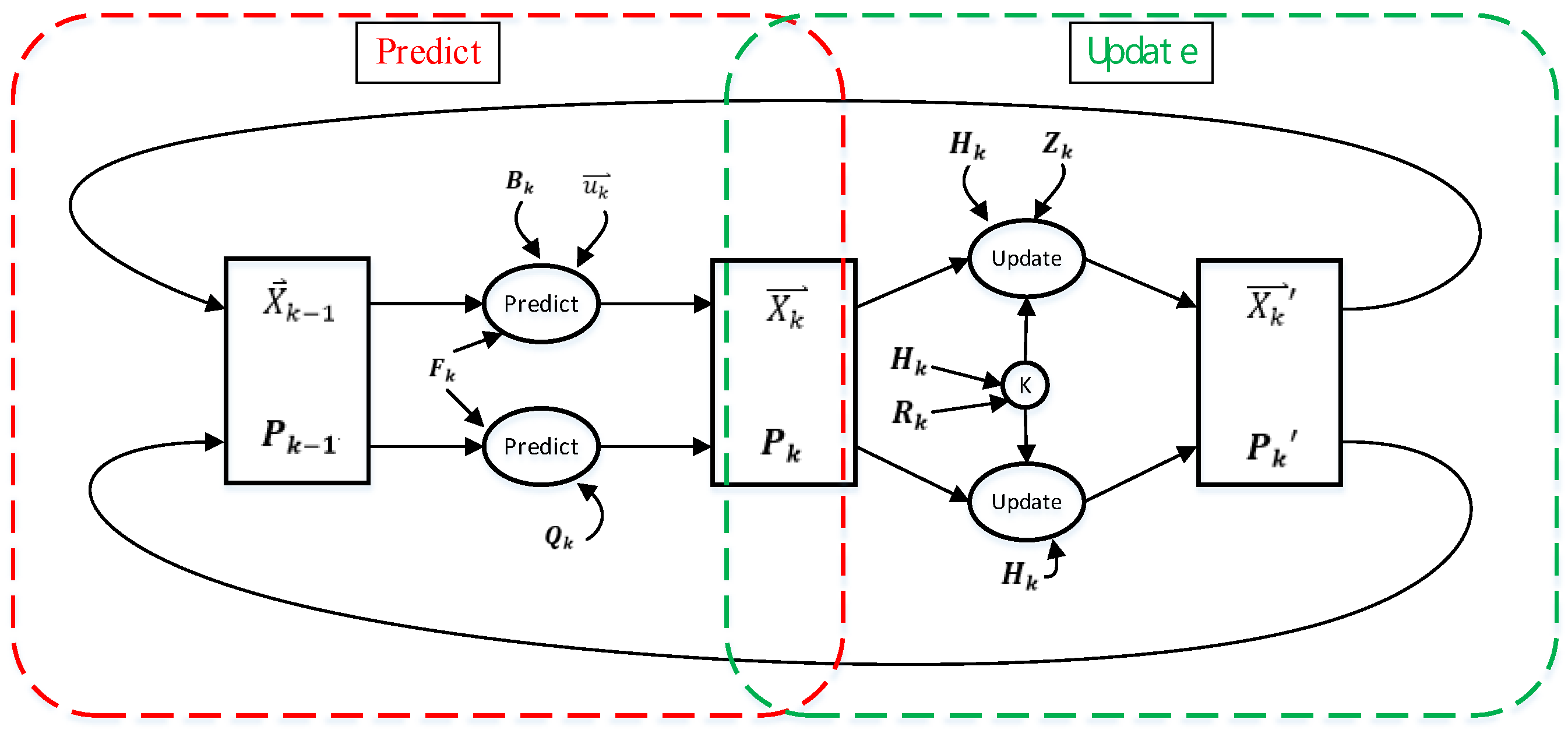

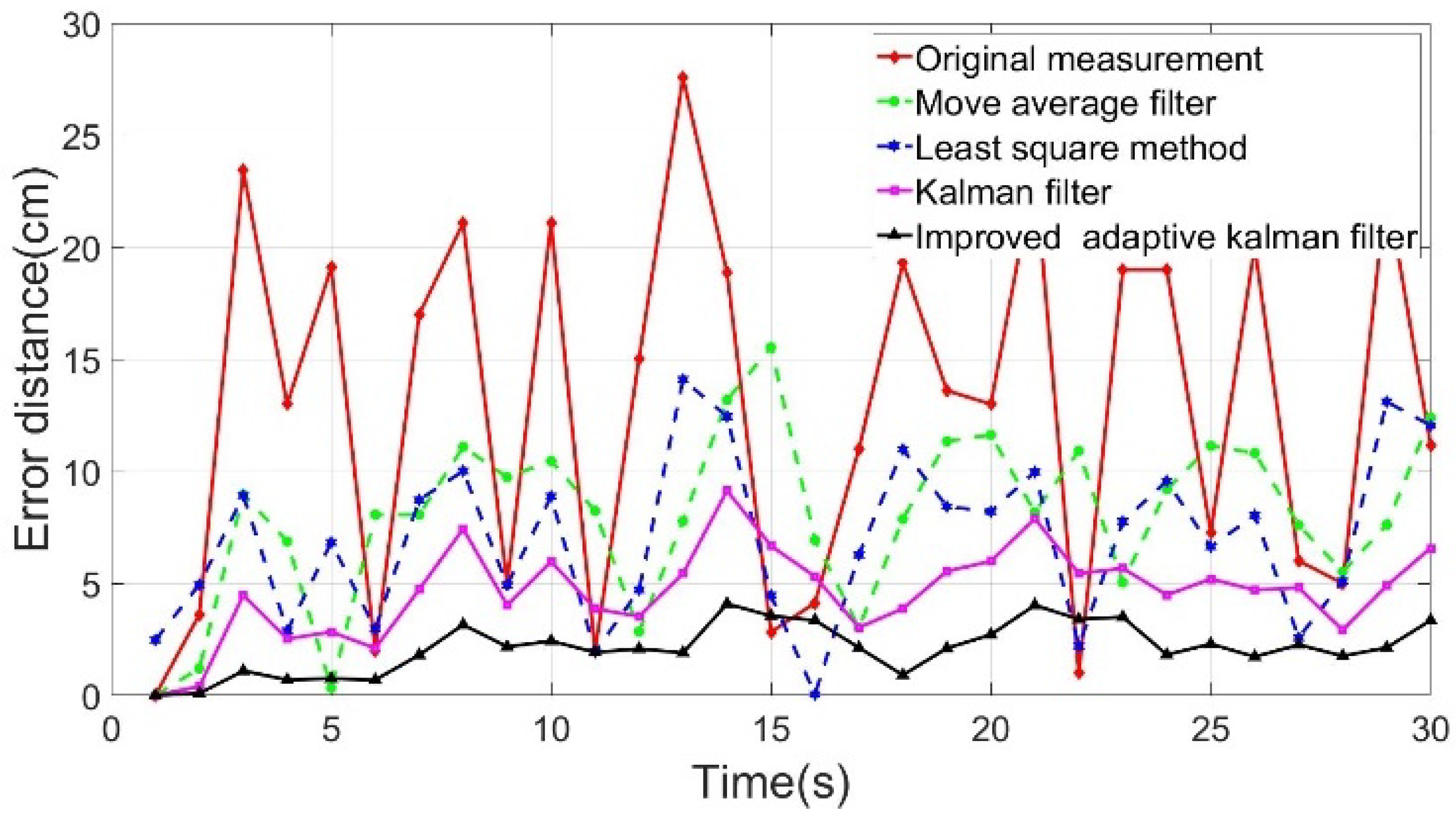
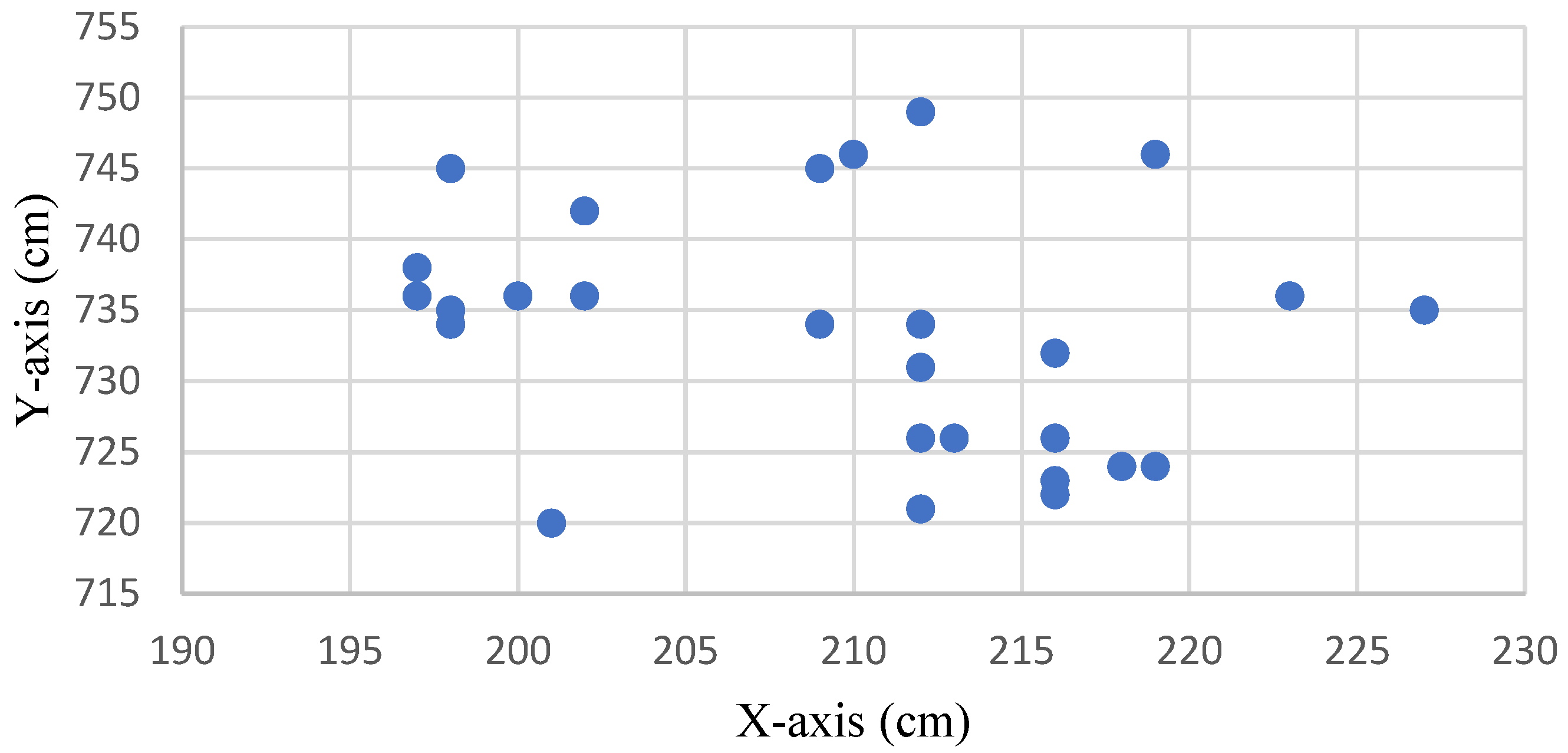

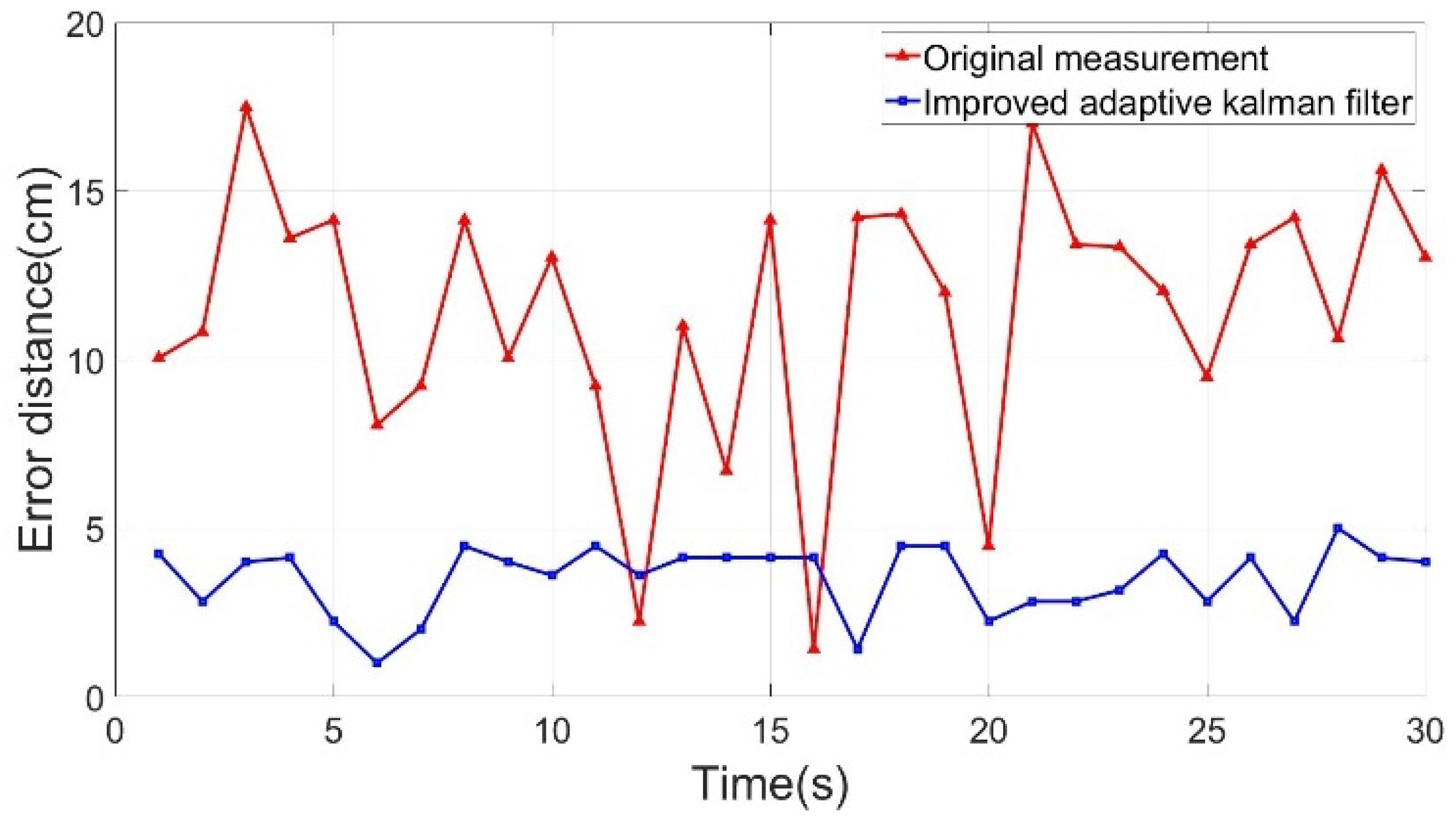
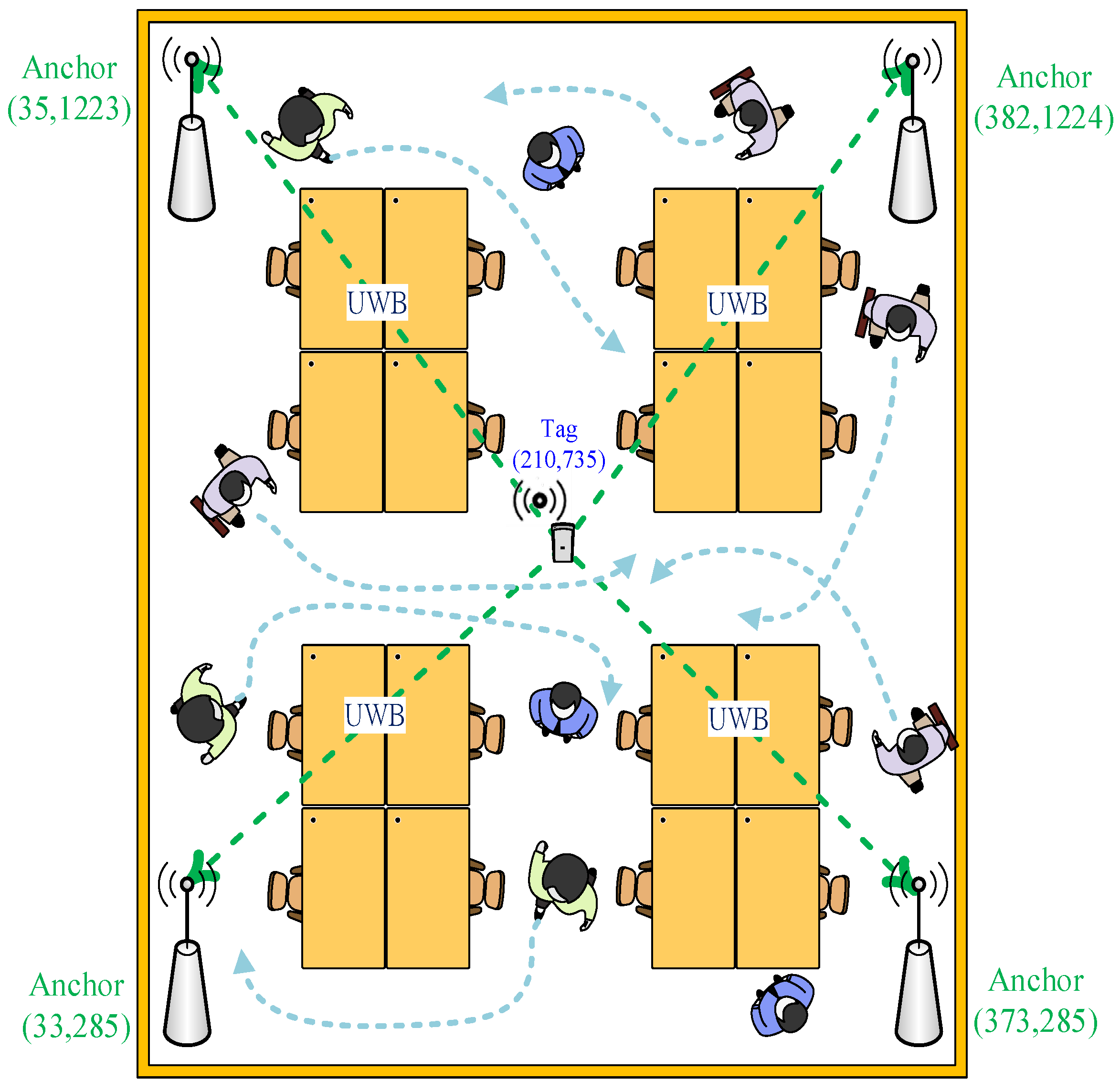
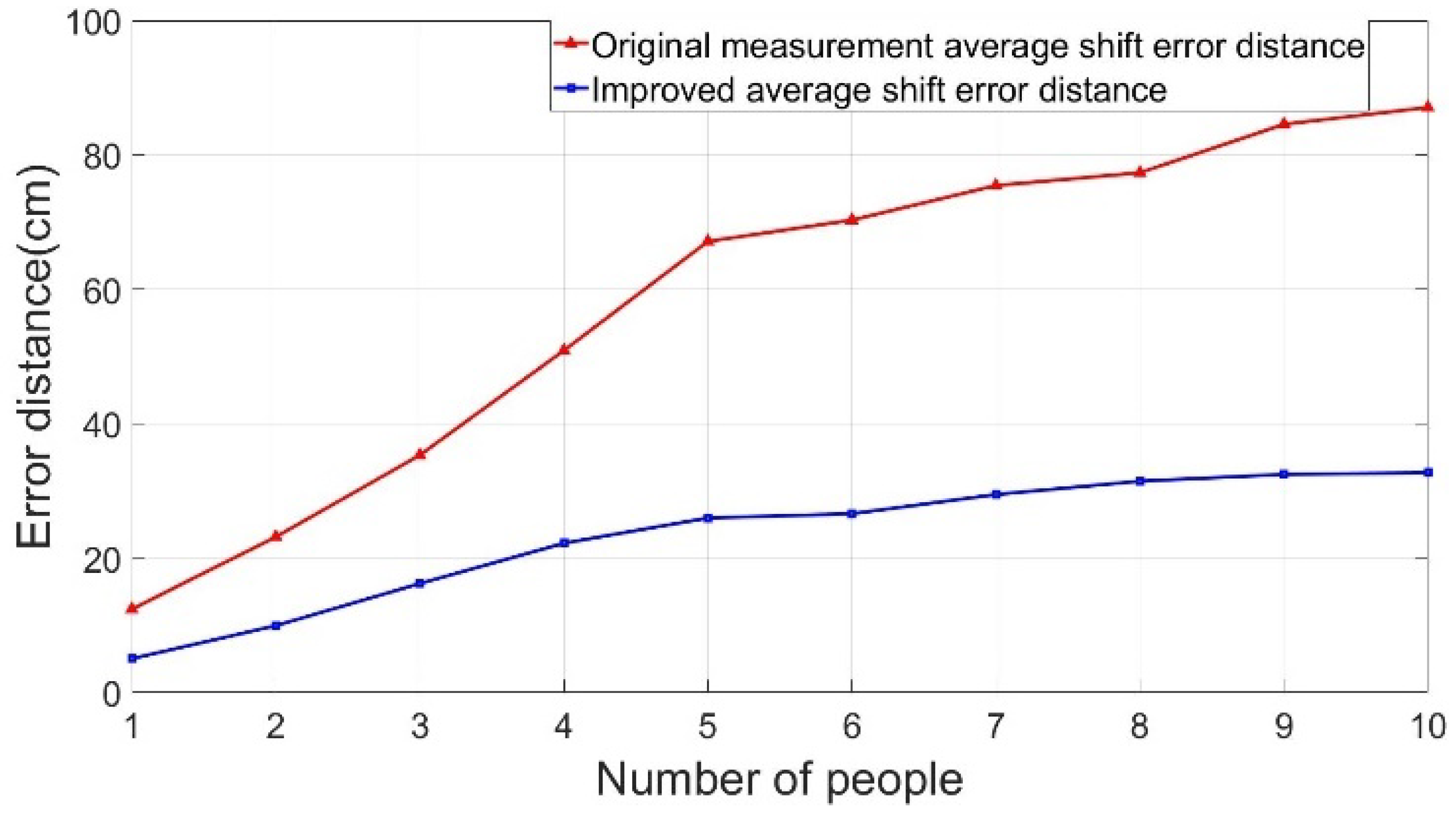



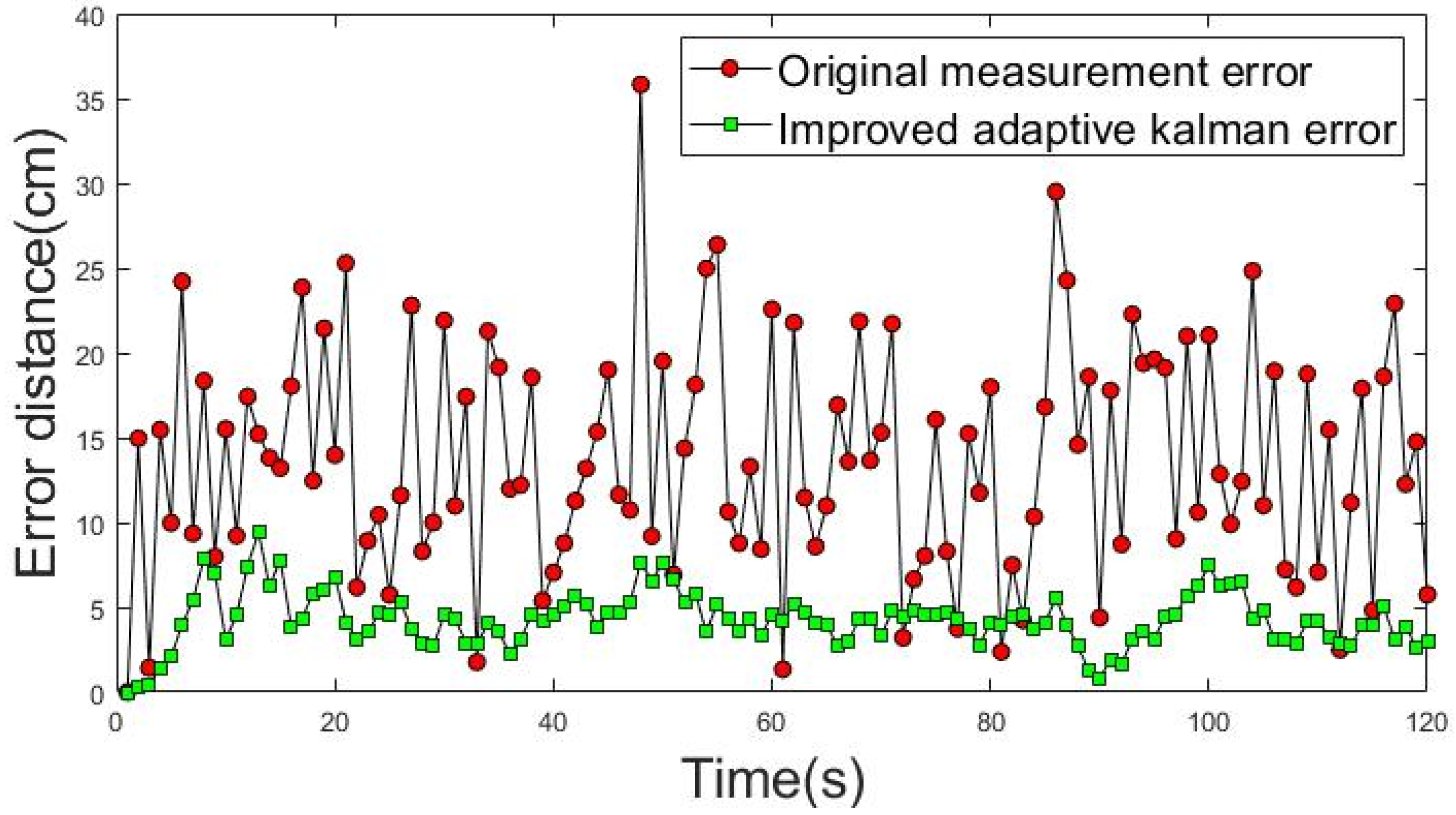

| Algorithm | Average Shift Error Distance (ASED) | Improvement (%) |
|---|---|---|
| Original Measurement | 12.91 cm | N/A |
| Moving Average | 8.05 cm | 37.65% |
| Least Square | 7.01 cm | 45.7% |
| Kalman Filter | 4.65 cm | 63.98% |
| Improved Adaptive Kalman Filter | 2.13 cm | 83.5% |
Publisher’s Note: MDPI stays neutral with regard to jurisdictional claims in published maps and institutional affiliations. |
© 2022 by the authors. Licensee MDPI, Basel, Switzerland. This article is an open access article distributed under the terms and conditions of the Creative Commons Attribution (CC BY) license (https://creativecommons.org/licenses/by/4.0/).
Share and Cite
Lin, S.-H.; Chang Chien, H.-H.; Wang, W.-W.; Lin, K.-H.; Li, G.-J. An Efficient IAKF Approach for Indoor Positioning Drift Correction. Sensors 2022, 22, 5697. https://doi.org/10.3390/s22155697
Lin S-H, Chang Chien H-H, Wang W-W, Lin K-H, Li G-J. An Efficient IAKF Approach for Indoor Positioning Drift Correction. Sensors. 2022; 22(15):5697. https://doi.org/10.3390/s22155697
Chicago/Turabian StyleLin, Shang-Hsien, Hung-Hsien Chang Chien, Wei-Wen Wang, Kuang-Hao Lin, and Guan-Jin Li. 2022. "An Efficient IAKF Approach for Indoor Positioning Drift Correction" Sensors 22, no. 15: 5697. https://doi.org/10.3390/s22155697
APA StyleLin, S.-H., Chang Chien, H.-H., Wang, W.-W., Lin, K.-H., & Li, G.-J. (2022). An Efficient IAKF Approach for Indoor Positioning Drift Correction. Sensors, 22(15), 5697. https://doi.org/10.3390/s22155697






